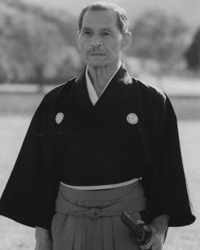IAIDO.COM
JAPANESE SWORDSMANSHIP - IAIDO, IAI-JUTSU, KENDO, KENJUTSU, BATTO-JUTSU


IAIDO.COM
JAPANESE SWORDSMANSHIP - IAIDO, IAI-JUTSU, KENDO, KENJUTSU, BATTO-JUTSU
IAIDO.COM recommends the Japanese Martial Arts Center in Ann Arbor, Michigan, where intensive courses are offered in iaido, judo, and jujutsu (jujitsu). Kendo is practiced in a weekly workshop. See the Japanese Martial Arts Center site.





Hosted by Network Services Group, LLC
The jo is a four-foot wooden staff, so jodo is "the way of the staff." Techniques with the jo include striking, poking, parrying, and blocking. Some styles include joint locks and throws, which are executed against an opponent who grasps your weapon. Traditional jodo is highly systematized, with practice drills and kata, as well as individual self-defense techniques. Practice is active, but not nearly as intense as judo or karate.
Kenjutsu means "the way of the sword," but the arts with this name are distinct from iaido and kendo. In kenjutsu, wooden swords are typically used, rather than metal practice swords or shinai. These systems usually emphasize fighting techniques more than formalized kata, and are often much more active than iaido. Legitimate schools teaching kenjutsu in the traditional manner are very rare outside Japan.
The naginata is a long-handled weapon with a short, curved blade at one end. These days, the art of naginatado is primarily practiced by women in Japan, though a few men do study it. Practice is much like kendo, with individual technique practice, kata, and sparring, with kendo armor and weapons that have short, split-bamboo blades like the shinai. Practice of this art can be quite strenuous, depending on how much the teacher enjoys hard work.
Ninjutsu is "the art of the assassin." Proponents claim that there is an unbroken tradition of techniques and theory dating back several hundred years, but this idea is in some dispute. Reputable modern historians say that the original ninja were disorganized opportunists, and that the idea of a classical system was created only recently to help promote the art. Ninjutsu practice involves stalking and hiding techniques, climbing, the use of explosives, small weapons, and almost any other skill that could be useful to an assassin. Students often wear black from head to toe, and much of the training is done outdoors.
There are six weapons considered to be the classical weapons of the Okinawan warrior. Most of these were adapted from farm implements and some were used to fight the Japanese invaders of Okinawa, who forbade the Okinawans to use swords. A system of defensive techniques and one or more kata was devised for each weapon. The six classical weapons are the rokushaku bo (six-foot staff), the sai (short, pitchfork-like weapons), the tonfa (made from grinding wheel handles), the nunchaku (threshing handles), the kama (small, hand-held scythes), and the noburi kama (a long-handled version of the kama).
All kobudo systems teach interesting techniques and are good as a second or third martial art. Most are considered minor systems, however, because they contain many different skills rather than one dominant type, such as the throwing techniques of judo or the striking found in karate. These characteristics mean that kobudo training often creates students who are "jacks-of-all-trades," rather than masters of one. - from BUDO MIND AND BODY, by Nicklaus Suino.
IAIDO.COM - ALL ABOUT JAPANESE SWORDSMANSHIP
IAIDO, IAIJUTSU, IAIGIRIDO, KENDO, KENJUTSU


The Art of Japanese Swordsmanship
www.artofjapaneseswordsmanship.com
Presents
IAIDO: The Late Yamaguchi Katsuo
Meijin 10th Dan
Muso Jikiden Eishin-Ryu Iaido
Inspired by the defensive sword techniques of the samurai warrior, iaido focuses on cutting down the opponent at the instant of attack. Few arts teach more effective methods of drawing and cutting with the katana.
Yamaguchi Katsuo was one of the last great swordsmen of the pre-war generation. He was famous worldwide for his crisp technique, attention to detail, and extraordinary presence. Before his death, he was granted the highest possible title and rank by the All Japan Iaido Federation and Kokusai Budoin, that of Meijin 10th Dan.
In this video, Yamaguchi Sensei demonstrates virtually the entire solo curriculum of Eishin-Ryu Iaido, showing each technique from the front and from the side.
For more information on the techniques, philosophy, and instructors of
Muso Jikiden Eishin-Ryu Iaido, see www.japanesemartialartscenter.com.
Kobudo (literally, "ancient martial art") does not refer to a single art, but rather to a group of arts including iaijutsu and battojutsu, jodo, kenjutsu, naginata-do, ninjutsu, various old styles of jujutsu, the Okinawan weapons arts, and others. You cannot obtain a rank in kobudo; instead you study one or more of the specialized arts that are included in it, each of which has unique characteristics.
Iaijutsu and battojutsu are basically the same as iaido, though the techniques often retain more of the flavor of fighting techniques than Zen ritual. These systems also encourage cutting practice, using rolled straw mats or bamboo, whereas many iaido schools discourage cutting, claiming that such practical application of the techniques is unnecessary.
BUY THE COMPLETE VIDEO at